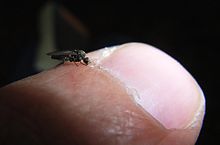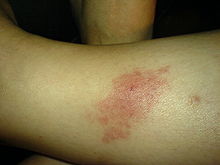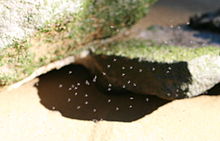- Sandfly
-
Sandfly (or sand fly) is a colloquial name for any species or genus of flying, biting, blood-sucking Dipteran encountered in sandy areas. In the United States, sandfly may refer to certain horse flies that are also known as "greenheads" (family Tabanidae), or to members of the family Ceratopogonidae, also known in Florida and elsewhere as a sand gnat, sandflea, no-see-um (no-see-em, noseeum), granny nipper, chitra, punkie, or punky. Outside the United States, sandfly may refer to members of the subfamily Phlebotominae within the Psychodidae. Biting midges are sometimes incorrectly referred to as sand flies. Biting midges, also known as no-see-ums (no-see-em, noseeum), are insects that belong to a different biological group and should not be confused with the sandflies.
While horse flies are large flies, noseeums (sandfleas) and some Old-World sandflies are tiny midges. Sandfly bites may leave large, red itchy bumps that may turn into a rash. These bumps are frequently several times as itchy as mosquito bites, and tend to last longer as well.
In the various sorts of sandfly only the female is responsible for biting and sucking the blood of mammals, reptiles and birds. She requires the protein in the blood to make her eggs.
Some sandfly genera of the Phlebotominae subfamily are the primary vectors of leishmaniasis and pappataci fever; both diseases are confusingly referred to as sandfly fever. In the New World, leishmaniasis is spread by sand flies of the genus Lutzomyia; in the Old World, the disease is spread by sandflies of the genus Phlebotomus. Belize and Honduras are notorious in the Caribbean for their sandfly populations and travel pages frequently warn tourists to bring bug spray containing high concentrations of DEET.
Contents
Viruses
Among the viruses that sandflies can carry are Chandipura virus, which as a cousin of rabies, is very deadly as in an outbreak in India in 2010.
Prevention
Counter-top repellents with high concentration of DEET or Picaridin are proven to work, but may not be suitable to some people, eg. people with sensitive skin and pregnant women. Some alternative substances anecdotally reported to be of use are:[1]
- Orange Peel
- Any citrus juice
- Eucalyptus oil
- Coconut oil
- Avocado oil mixed with Dettol
- Baby oil mixed with Dettol
- Chinese herbal oil
- Essential lavender oil
- Tea tree oil
- Listerine
- Tiger Balm
- Eucalipto
- Vicks VapoRub
- Vinegar
- Marmite, Promite, Vegemite – anything with high Vitamin B content
This list contains mostly substances with unproven effectiveness, ranging from quite effective to ineffective.
A particular extract of Lemon Eucalyptus oil (not the essential oil) has now been shown to be as effective as DEET in various studies.[2][3]
Most information on repellents focuses on mosquitos, but mosquito repellents are effective for sandflies and midges as well.[4]
Remedies
There are a number of remedies for sandfly bites. Below are some of them.[1]
Pharmaceutical remedies:
- Calamine lotion
- Ibuprofen Gel
- Hydrocortisone cream 1%
- Xylocaine gel 2%
- Antihistamine
- Avon ‘Skin So Soft’
- Hydrocortisone cream
- Tea tree oil
- Essential lavender oil
Home remedies:
- Baking soda with water
- Vinegar
- Aloe vera
- Toothpaste
- Onion
Cultural views
New Zealand sandflies (which are actually a different insect and a type of black fly)[5] have a native Māori legend wherein "the god Tu-te-raki-whanoa had just finished creating the landscape of Fiordland, it was absolutely stunning... so stunning that it stopped people from working. They just stood around gazing at the beauty instead. The goddess Hinenuitepo became angry at these unproductive people, so she created the sandfly to bite them and get them moving"[6]
These sand flies were able, according to another Maori legend, to revive the dead hero Ha-tupatu.[7]
References
- ^ a b Sandfly Bites & Prevention[unreliable medical source?]
- ^ Trigg, JK (1996). "Evaluation of a eucalyptus-based repellent against Culicoides impunctatus (Diptera:Ceratopogonidae) in Scotland". Journal of the American Mosquito Control Association 12 (2 Pt 1): 329–30. PMID 8827615.
- ^ Carroll, SP; Loye, J (2006). "Field test of a lemon eucalyptus repellent against Leptoconops biting midges". Journal of the American Mosquito Control Association 22 (3): 483–5. doi:10.2987/8756-971X(2006)22[483:FTOALE]2.0.CO;2. PMID 17067050.
- ^ CDC: West Nile Virus – Updated Insect Repellent. Cdc.gov (2009-10-13). Retrieved on 2011-06-15.
- ^ Sandflies and mosquitoes – Sandflies: New Zealand’s blackflies – Te Ara Encyclopedia of New Zealand. Teara.govt.nz (2009-03-01). Retrieved on 2011-06-15.
- ^ Sandflies – New Zealand – IgoUgo – stomps. IgoUgo (2008-06-04). Retrieved on 2011-06-15.
- ^ Ha-tupatu and the sand flies. Maori.org.nz. Retrieved on 2011-06-15.
External links
- Sand Flies – Beaufort County Library (via Internet Archive)
- Infectious skin disease found in Texas September 15, 2007 Breaking News – Sandfly may carry parasites that will cause infectious skin disease called leishmaniasis.
- Biting midges and no-see-ums --University of Florida
Categories:- Flies
- Biting insects
Wikimedia Foundation. 2010.



